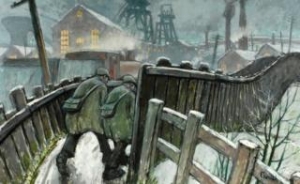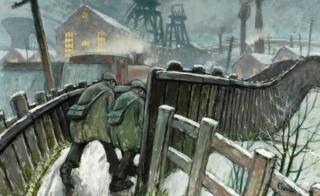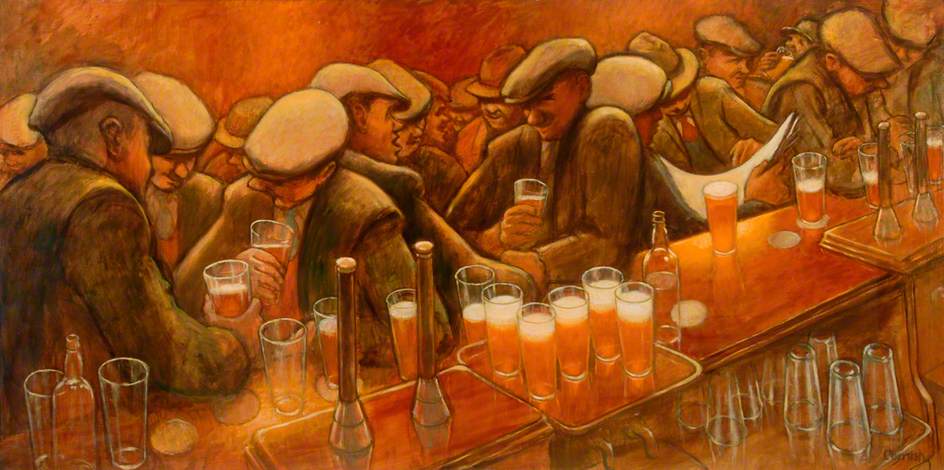The idea begins to take shape after the fortuitous discovery of the pale blue savings account book, wedged between two long-expired passports, and secured with an elastic band. It belonged to my deceased mother, and it reads Postsparbuch and Deutsche Bundespost. There’s a posthorn-shaped logo near the top of it with stylised lightning flashes underneath, which reminds me of the muted posthorn symbol representing Thurn und Taxis in Thomas Pynchon’s metafictional novel The Crying of Lot 49. The final entry is from 28 July 1999. Since that also happens to be the same year in which Germany switched from the deutschmark to the euro, the balance is given in both currencies: 2154.68 DM versus 1101.67 EUR. It almost feels like unearthing buried treasure. In a sense, it is.
I email the Postbank, since that is what they are now called, attaching scans of my passport, my mother’s death certificate, and the savings account book, and make enquiries to withdraw the money, which most definitely belongs to me and not to them. Unfortunately, it’s not as simple as all that. Copies are not acceptable for inheritance purposes. Instead, I’ll need to arrange a trip to Germany, armed with all the original documents. To that end, I order a two-prong power adapter for my mobile phone and it arrives promptly, the day before I’m due to travel.
As I’ve grown older, sudden change and new experiences have become less and less attractive. If anything, I tend to avoid them and stick to a routine. But as a poor working-class writer, the thought of getting my hands on some extra money – which will have been augmented by 24 years of interest – is too great to resist.
To be honest, I’d forgotten all about this savings account. My late father, who was an avid grower of prize-winning exhibition leeks, used to be busy during the summer months feeding and watering his charges, so my mother would sometimes go on holiday to Germany on her own. She opened the account so that it would be a relatively simple matter for her to withdraw spending money as and when required, rather than needing to use the services of a bureau de change. After developing vascular dementia, she was unable to make any more such trips, and she died in 2007.
So, on the 25th of September 2023, I set off for Düsseldorf. It makes sense to go to my mother’s place of birth, given that I am travelling by Eurostar. If you know your geography, Düsseldorf, along with Aachen and Cologne, is one of the first major cities you encounter after the train crosses the border from Belgium into Germany. I already know there’s a branch of the Postbank directly over the road from Düsseldorf Hauptbahnhof, which is handy.

It’s nearly fifty years since I’ve seriously been required to speak German, even though I’m a translator from that language – my book Autumnal Elegies is a translation of the poetry of the Austrian Expressionist Georg Trakl. So, first of all, I need to establish some essential vocabulary items. Testamentsvollstrecker (executor) is a bit of a mouthful, as is Sterbeurkunde (death certificate). They do so love their compound nouns, my splendid Kraut compatriots, God bless ’em!
Mittwoch/Wednesday
I’ve made the journey from Darlington to Kings Cross many times. Over those years, only the trains and rolling stock have changed. First there was the era of the Class 55 Deltic, then the Class 43 HST, and now the Class 800 Azuma. So, here I am at Bank Top Station, waiting for the 9.00 a.m. service. I’m in coach J and I’ve got a window seat.
The arable fields look like they’ve had the equivalent of a number one cut, whereas others have been recently ploughed. At this time of year, the crops have been harvested, by and large, though some corn is still standing in places. The farmers have dyed the fleeces of their sheep green for ownership purposes. Here and there, horses graze peacefully.
As I compile these notes, it’s awkward writing using the drop-down flap in the back of the seat. Next time I embark on such a project, I’ll choose a seat with a proper table. Further on, there’s the familiar sight of plumes of steam above the massive Drax power station, which provides 6% of the UK’s electricity.
Whenever I set foot in London I’m always reminded of these lines by Baudelaire from his “Les Sept Vieillards”:
Fourmillante cité, cité pleine de rêves,
Où le spectre en plein jour raccroche le passant!
Despite its numerous artistic and architectural attractions, I loathe the place. Its monstrous size overwhelms me, and navigating through it fills me with dread. But today is different, since all I need to do upon exiting Kings Cross is to make my way over the road near the taxi rank and enter St. Pancras station.
One of the reasons for choosing to travel by Eurostar is for research purposes. The villain in the sequel to my thriller Black Art is going to make his escape to the Continent using that means of transport, so I need to understand the security protocols he’d encounter. As for myself, it’s relatively painless, though I do manage to set off the metal detector when I walk through it and am brusquely frisked by a member of staff.
It’s now time to wait amongst a throng of people for the train to be assigned a platform. Since I’m a novice, I scrutinise the faces of those in my vicinity and find a likely candidate. He strikes me as being a businessman, so he’s bound to know the ins and outs. He confirms that, given its coach number, my train to Brussels Midi will depart from one of three possible gates. In the event, I go through gate 6 because my coach number is 16. When I climb on board and find my seat, I estimate that only half of them are actually occupied. Because of the relatively short journey time, seating is maximised with no tables available in standard class.
Along the route, my ears pop a few times as we enter and emerge from various tunnels. At the approach to the Channel Tunnel in Folkestone, there are formidable sections of military-style fencing, like something you’d see in the West Bank. Soon we are plunging down through the chalk marl layer below the English Channel. Whereas earlier my ears were popping, now they are unaffected. We are travelling at 99 mph and it only takes fifteen minutes before we emerge into the sunlight of the Pas-de-Calais. We are now in another country.
Looking out of the window, I see identical fields under the plough, just as they were back home, the only difference being the make of the machinery that these French farmers are using. You can also see a change in the style of the houses along the route with their characteristically steeply pitched roofs. There are only two scheduled stops: Lille, followed by Brussels Midi.
Although the time seems to have progressed somewhat, that’s actually an illusion. The Continent is an hour in advance of the UK, and that’s true in many other ways. The next train I’m booked on is the TGV to Dortmund, which leaves at 5.25 p.m. It’s due out from Platform 6A. Whenever I think of the Train à Grande Vitesse, the album Trans Europa Express by Kraftwerk comes to mind, and it’s appropriate that the band’s Kling Klang Studio used to be adjacent to Düsseldorf Hauptbahnhof.
Already I’m juggling around the equivalent words in my head: platform, voie, gleis. Becoming mentally attuned to my new environment, as it were. From now on, English is no longer preeminent. The passenger announcements obey a strict hierarchy: French, Dutch and German, before we finally get to English. I’m fine with all that since I can understand French and German.
I find my seat, and a few moments later, a middle-aged woman joins me. When the ticket inspector reaches us, he already knows our surnames and so I decide to speak to my fellow passenger to work out which one of us is getting off first. She’s travelling to Aachen to stay with friends, so that means I’ll be fine to sit where I am in my window seat. The stops along the way include Aachen, Cologne and then Düsseldorf. I learn she’s a Senior Teaching Associate in German Studies at Lancaster University, with a particular interest in the East German writer Brigitte Reimann. Having recently enjoyed John Kampfner’s Why the Germans Do It Better, I mention this to my neighbour, but she’s already read that book and recommends it to her students.

The train pulls into Düsseldorf Hauptbahnhof at 8.30 p.m. local time. There are two exits and I choose the nearest one, which leads to the Bertha-von-Suttner-Platz. Walking a bit further, I soon realise that the surroundings don’t correspond with those I’ve seen on Google Street View. I therefore reluctantly retrace my steps and opt instead for the exit leading to the Konrad-Adenauer-Platz. That’s more like it.
Emerging from the station, I cross the tram tracks and walk along the Bismarckstraße before turning left into what I take to be the Karlstraße, though with it being dark, I’m unable to see any street sign. When I notice a couple approaching me, I stop them to confirm whether I’m headed in the right direction, but they are from Berlin. After getting slightly lost, I make my way over the road and can read the street name – it’s the Grupellostraße, after all. If I walk along here the hotel should be on my left on the corner with the Oststraße. And there it is – the Hotel Lindenhof.
Picking up my key from reception and filling in a paper form with my details, I receive a key to room 404, along with a slip of paper bearing the Wi-Fi code, and catch the lift to the fourth floor. After writing up some notes and plugging in the adapter to recharge my phone, I clean my teeth and prepare to go to bed. Since it’s only 10 p.m. there’s still some activity out in the street below near Yogi, the Korean restaurant, so I shut the window and draw the curtains. Intermittently, I hear emergency vehicles racing through the city streets, their wailing sirens illustrating and confirming the Doppler effect.
Donnerstag/Thursday
I’m up for eight o’clock, and after showering and dressing, I go down to breakfast. But by now it’s nearly nine o’clock, which is when the Postbank, which is situated on the Immermanstraße, opens its doors to the public, so I decide to skip breakfast. I can always grab a snack later.
When I arrive at the bank, only a handful of people are waiting to see one of the cashiers. Typically, the word for a queue in German is Schlange (snake) which is an appropriate image for such a group of people as they wind along. Anyway, in less than five minutes I reach one of the cashiers, and from the word go, I’m into my stride. From now on, the German language takes precedence – there’ll be no lapsing back into English, I’m afraid.
It turns out that the Postbank is already aware of my mother’s death. As for the accrued interest, the revised account balance is now €1200. It’s not much of an increase, given that the interest covers a period of 24 years, but it still makes my trip eminently worthwhile. I produce the last will and testament, the death certificate, the savings account book, and, for ID purposes, my own passport. I’ve also brought along my mother’s old passport and my original birth certificate, but they are not required.
Eventually, I’m asked whether I have a bank account in Germany. I don’t. What about a relative or friend? Nope. Well, that makes matters more complicated, I’m afraid. I’ll need to provide my 22-digit IBAN number so that the Postbank can make a bank transfer to my English account. The trouble is that I don’t know my IBAN number. So what to do next?
I abandon my quest for now and return to the hotel to think things through. I consider possible solutions. What about opening a bank account in Germany? After all, that’s what my mother did. Instead, I decide to ring Lloyds Bank in the UK and ask them to give me my IBAN number. After a five-minute wait, I’m through to the helpline and the call centre agent gives me my IBAN number along with the “big number” whatever that is.
The snake at the Postbank is longer than last time. When I reach one of the cashiers, it’s a different woman to the one with whom I spoke earlier. So, effectively, I need to go through the whole palaver once more, right from the beginning. At last, I’m asked to sign a form, which will enable the money to be transferred to my bank account, and the old savings account book has its corner clipped like they do with expired passports. I volunteer my phone number in case there are any problems. Worst-case scenario, I’ll receive a cheque in the post.
Exiting the Postbank, I notice that there’s a language school next door called Düs-Eckert. That’s hugely significant, given the fact that Eckert was my mother’s maiden name, and that my cousin Ursula was a translator. I gather she even worked in that capacity for the European Parliament. What are the chances the language school bears the name of my mother’s family because one of their number founded it? That’s certainly something to bear in mind.
In total, this rigmarole at the Postbank has taken nearly two hours to bring to a satisfactory conclusion and I’m famished, so I go to the nearby Back-Factory where I opt for a freshly made brötchen with salami which only costs €2.50. Admittedly, this brötchen is not as fresh as the ones my uncle Hans used to bring us directly from the oven in his Düsseldorf bakery, but it’s still pretty damned good all the same. Like an idiot – I blame my long distance spectacles for the error – I mistakenly hand over a fiver instead of a five-euro note. They are the same colour after all. The man behind the counter laughs and asks what it is. He hasn’t seen one before. I tell him it’s a five-pound note, hand him the correct currency and receive my change.
After the stress of engaging in two prolonged conversations in a language that I haven’t used for nearly fifty years, I go back to the hotel to write up some more travel notes before I go for a well-earned lie down. At least I’ve managed to successfully negotiate the most difficult part of the trip.
That evening I go for a mooch around the local area, now that I’ve got to grips with its layout. These days, Düsseldorf is an exceedingly cosmopolitan city, and the area in the immediate vicinity of the hotel is known as Little Tokyo in terms of its many Japanese restaurants, although there are also establishments offering Thai, Korean, Vietnamese and Chinese cuisine. I have to admit that Japanese food isn’t a favourite of mine, and sushi is a definite no-no, so I’m going to grab some more conventional fare later on after I find a bar.
I ask for a helles Bier (lager) and sit down at a table, temporarily distracted by a Sky Sports feature on Harry Kane, who has himself made the journey to Germany to play for Bayern Munich. When I check the drinks menu, I notice they sell bottled malzbier, a non-alcoholic beer I used to love as a kid. I’m tempted to buy a bottle but don’t fancy the hassle of carrying it about with me, so decide against it. Besides, I’m ravenous by now, so I opt for some fast food instead.
I have a kebab at a place called Mangal near the railway station. It was opened only a few months ago by the former Arsenal footballer Lukas Podolski. Although there was no choice when it came to which language I spoke in the Postbank, now the challenge is to speak German whenever I get the chance. So, as in the bar, I approach the lads behind the counter, this time asking for Döner mit Chilisoße, bitte. (Doner with chilli sauce, please.) But, if you do that, you always need to be prepared for the inevitable follow-up questions. What sort of meat do I want with my kebab? Rindfleich (beef) or Huhn (chicken)? Which items of salad would I like? Do I want mitnehmen (takeaway) or hier-essen (eat-in?) I opt for the latter.

I’m back at the hotel by nine o’clock. After I open the door to my room, something totally unexpected happens, which freaks me out. Despite having wiped my hands with a paper napkin in the kebab shop, I think to myself in German as I’m standing outside the bathroom: Ich muss meine Hände waschen. (I must wash my hands.) At this rate, how long will it be before I start dreaming in German?
Writing up a few more travel notes and recharging the phone, I clean my teeth and go to bed. The train back to Brussels Midi leaves at 6.16 a.m., so I’ll need to get up for 4.30 a.m. or thereabouts, and as a precautionary measure I set the alarm on my phone.
Freitag/Friday
I’m up at 4.30 a.m., without requiring the insurance of the alarm. After showering and dressing, I make sure I haven’t left anything behind in the room and go down to the reception desk. When I describe the hotel as bequem (comfortable) to the man behind the counter, he replies Alles klar which almost makes me snigger, thinking of the character of Herr Lipp from The League of Gentlemen.
At the station, I spend some of my loose change on a bottle of pop and wait for the departure board to display the platform number for the 6.16 a.m. Thalys service to Brussels Midi. When the information becomes available, I stroll towards the relevant platform and make my way up the escalator. A German couple is waiting nearby, and the woman is carrying a capacious bag, featuring a London bus design. When the woman catches my eye, she asks me if I know the order of the coaches. I was just about to ask you the same thing, I reply. Since we are in the same coach, we stick together and eventually learn from one of the station staff that coach 28 is right at the front of the train, so we make our way towards it along the platform.
There’s not much to see with it being completely dark. The train begins to fill up after Aachen and soon it starts to get light. It makes me wonder if anyone has written about and studied the various graffiti tags and messages that are prominently sprayed on walls along the route. And as we approach Belgium, I wonder if the train goes past any of the controversial Belgian nuclear power plants, which, because of their proximity, led to a surge in support for the Greens in Germany.
Waiting for the train to be assigned a platform before it is able to come to a halt at Brussels Midi, I chat to a woman sitting in the corridor. She compliments me on my German, even though I’m convinced it’s barely adequate. I see her later in the queue for the Eurostar.
On the 9.51 a.m. to St. Pancras, I sit with an orthodox Jewish man, his partner and their three boisterous children. The bespectacled paterfamilias observes the strict dress code of his religion and is wearing an impressive black hoiche hat which he removes, only to reveal the obligatory kippah underneath. He also has four tasselled strings attached to his trousers – the tzitzit. It’s a largely uneventful journey and we are soon approaching St. Pancras.
Thankfully, there are no further passport or ticket checks before I exit the station. Over the road at Kings Cross, a black guy is schlepping around a duvet. He tries one of the cashpoints to no avail. All the time he’s on his mobile asking about his ESA. It’s a sobering thought to know there are always people in a worse position than yourself. While I wait for the platform number of my train to be confirmed, two people ask me for money, and one of them goes round the assembled passengers twice before he is actively discouraged from doing so by a member of the Kings Cross security staff. As it happens, I’ve only got twenty-five euros in my bag and fifteen quid in my wallet, so I’m hardly rolling in money at the moment.
About to embark on the last leg of the journey, I buy a bottle of pop and a sandwich from the little Waitrose and a cup of coffee from Leon. Reflecting upon the events of the last three days, from a logistical point of view, travelling from Darlington to Düsseldorf by train makes no sense whatsoever. It’s far too protracted. But as I remarked earlier, I had my reasons for doing so. If you live in the Northeast of England, you’re certainly better off catching a train to Newcastle-upon-Tyne, taking the Metro to the airport and then boarding a flight, since the latter only takes 90 minutes. The Eurostar is therefore much more suitable for people living in the London area who might wish to visit Brussels or Paris. If those are your circumstances, it’s definitely a no-brainer.
****
Four months later, the money from Germany reaches my bank account. So my mother has come to the rescue once again, this time from beyond the grave. I’m not talking about these matters purely from a financial perspective, but because this economic shot in the arm is arguably only made possible by the language skills which I inherited from her. As the woman said to me on Düsseldorf Hauptbahnhof, “think of the money in the Postbank as an early Christmas present,” before adding, “besides, it’s only right that it should be in your pocket rather than in theirs.” Genau!




















